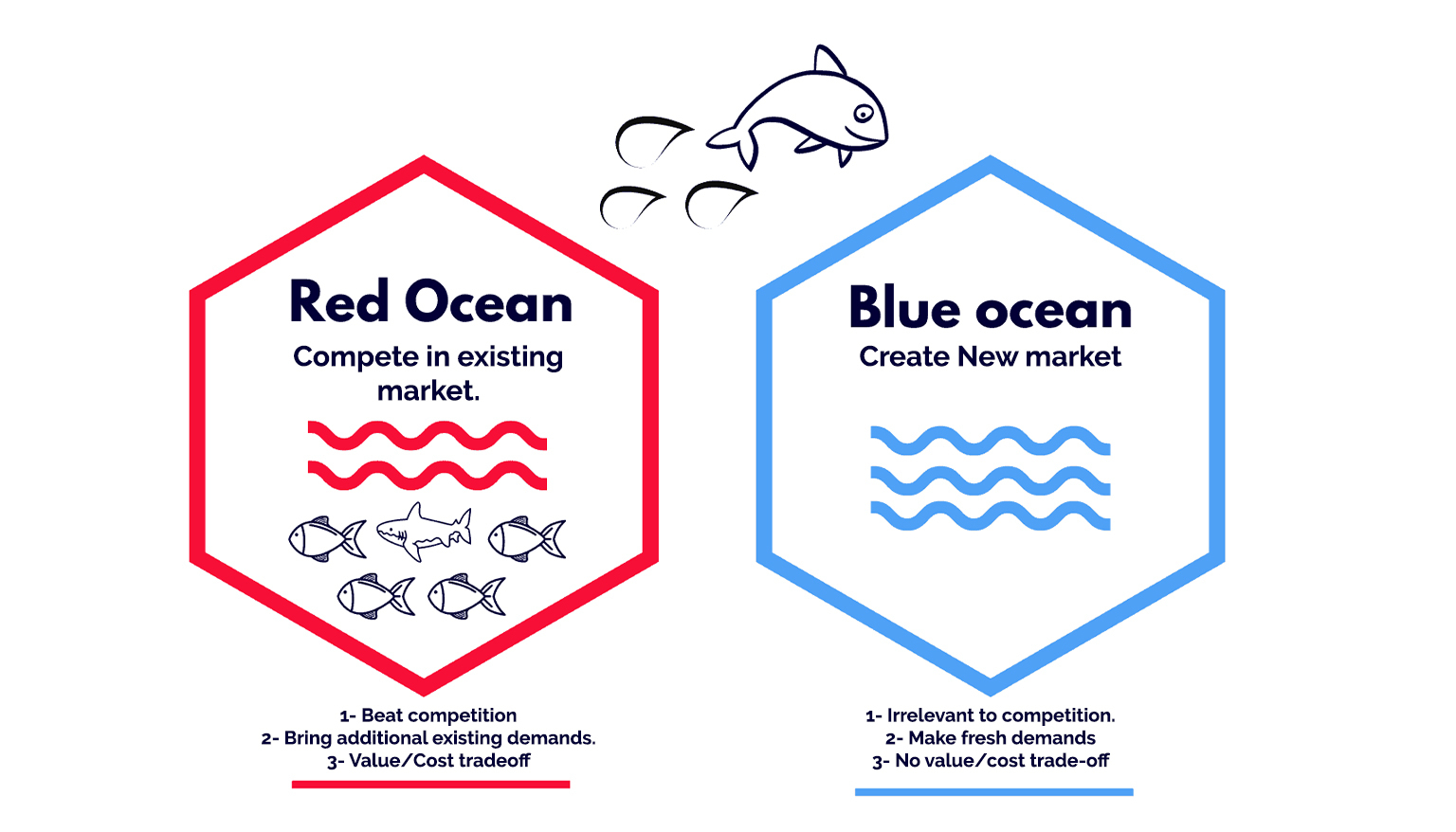
What is the Blue Ocean Strategy?
What if there was a way to avoid all the competition in business?
It’s called the Blue Ocean Strategy, where entrepreneurs focus on creating new market space rather than competing in existing markets.
It’s like discovering a fresh, uncontested ocean where you can sail without any sharks.
Blue Ocean Strategy is a transformative business approach that focuses on creating uncontested market spaces by offering innovative products, services, or business models that render competition irrelevant.
Introduced by W. Chan Kim and Renée Mauborgne in their seminal book, this strategy aims to unlock new demand and achieve sustainable growth by challenging industry conventions.
Blue Ocean Strategy emphasizes the importance of focusing on non-customers to redefine market boundaries and attract new demand. Companies can unlock new growth potential and establish a solid competitive advantage by addressing the barriers that prevent non-customers from engaging with the industry.
But to fully understand a blue ocean type of offensive strategy, you first have to define Red Ocean Strategy.
In the Red Ocean, companies compete fiercely for market share, often resulting in price wars, commoditization, and diminishing profit margins. The term “red” symbolizes the bloody battleground of competition, where rivals fight head-to-head for the same customers and resources.
Blue Ocean Strategy and Red Ocean Strategy:
Blue Ocean Strategy:
- Focuses on creating new, uncontested market spaces by offering innovative products, services, or business models that make the competition irrelevant.
- Emphasizes value innovation, which involves both reducing costs and increasing benefits for customers.
- Encourages companies to look beyond existing customers and explore potential demand from non-customers to expand market boundaries.
- Aims to create and capture new demand, making competition less relevant and potentially leading to long-term growth and higher profit margins.
Red Ocean Strategy:
- Focuses on competing in existing market spaces by outperforming rivals within the current industry boundaries.
- Typically, it involves fighting for market share within a well-defined and often saturated market.
- Often, it results in a race to the bottom, with companies competing primarily on price and incremental improvements to existing products or services.
- Can lead to head-to-head competition, with limited opportunities for differentiation and growth.
Types of Companies Suited for Blue Ocean Strategy (With Examples)
Startups and New Entrants:
New companies looking to enter a market can benefit from the Blue Ocean strategy as it helps them identify uncontested market spaces, enabling them to establish a unique value proposition and avoid head-on competition with established players.
Example:
Airbnb is a prime example of a startup that leveraged the Blue Ocean strategy. Instead of competing directly with hotels and traditional accommodations, Airbnb created a new market space by connecting travelers with hosts offering unique, local experiences.
Companies Facing Saturation or Declining Profits:
Organizations operating in mature industries or experiencing declining profits may consider the Blue Ocean Strategy to revitalize their business by exploring new growth opportunities and differentiation strategies.
Example:
In the early 2000s, Apple faced stagnation and declining profits. Under Steve Jobs’ leadership, the company shifted its strategy, launching innovative products like the iPod and iPhone, which created new demand and reshaped the consumer electronics market.
Companies Seeking Innovation:
Organizations aiming to foster innovation and challenge industry conventions may find Blue Ocean Strategy valuable, as it encourages creative thinking and new approaches to delivering value.
Example:
Netflix continuously innovates and challenges industry conventions. Starting as a DVD rental company, Netflix recognized the potential of streaming services and successfully transformed the entertainment industry by offering a unique, on-demand viewing experience.
Companies with Strong Resources and Capabilities:
Companies with strong resources and capabilities can leverage these to create and capture new market spaces, making them well-suited to pursue the Blue Ocean Strategy.
Example:
Amazon has used its vast resources and capabilities to create new market spaces. By leveraging its expertise in e-commerce and logistics, Amazon has ventured into new areas such as cloud computing (Amazon Web Services) and digital streaming services (Amazon Prime Video).
Companies with a Visionary Leadership:
Successfully implementing a Blue Ocean Strategy often requires visionary leadership that is willing to challenge the status quo and take calculated risks, as well as encourage and empower employees to embrace new ideas.
Example:
Tesla, led by visionary entrepreneur Elon Musk, has created a new market space in the automotive industry by focusing on electric vehicles and self-driving technology. Tesla’s success stems from its bold vision and commitment to innovation, challenging industry norms, and creating a unique value proposition for customers.
Key Principles of Blue Ocean Strategy:
Value Innovation:
Value innovation stands as the cornerstone of the Blue Ocean Strategy, which involves simultaneously pursuing differentiation and low cost to create a unique value proposition for customers. This is achieved by identifying factors that the industry takes for granted and eliminating or reducing them while also introducing new factors that create value for customers.
Strategy Canvas:
Four Actions Framework:
This framework outlines the strategic moves a company can make to create a new value-cost frontier. The four actions are:
Eliminate: Identify factors that the industry takes for granted and eliminate them if they no longer add value to customers.
Reduce: Identify factors that can be reduced without compromising the value proposition.
Raise: Identify factors that can be improved to create more value for customers.
Create: Introduce new factors that the industry has never considered to create new value for customers. reducing them while also introducing new factors that create value for customers.
